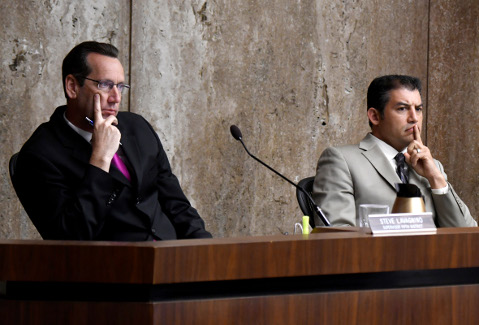Billion Dollar Budget Approved
More Money In but Even More Money Out

This year’s Santa Barbara County budget hearings were less lively than past years simply because there was little discretionary money for policy makers to fight over. But that doesn’t mean there was no fighting.
The county supervisors faced a $30 million shortfall. Squeezing the budget were employee pension costs, fire protection services, maintenance for roads, and future operational expenses at the Northern Branch Jail.
As property tax revenues increase, the stock market booms, and unemployment falls, County Supervisor Steve Lavagnino acknowledged the county’s financial woes might seem perverse. “Most of this is self-inflicted,” he said. “What we’ve done on this board hasn’t worked.”
The elephant in the room, conservative watchdog Andy Caldwell said, is that the county’s pension costs will gradually increase over the next four years. Later, he added the theme for this year’s budget was “elephants skating on ice.” (Preliminary figures show that next year the gap will be more than $20 million, CEO Mona Miyasato reported.)
For months, all county department heads prepared to downsize their budgets. By far the hardest hit was the Department of Social Services, in part because it received less from the state. Social Services initially prepared to lay off 71 staffers, most of whom process applications for social welfare, and demote another 28. Total, 188 employee positions, including vacant ones, were slated to be eliminated.
County Supervisor Janet Wolf led the charge to restore eight social worker positions, which she often refers to as the “human infrastructure.” Holding up a newspaper clipping of an ad Social Services had placed to recruit foster parents, Wolf expressed frustration so many social workers were on the chopping block. “If we can’t stand behind what we are saying to the community, I think we have a problem here,” she said. She objected to the fact $4 million of extra funding was allocated to repave roads and renovate county buildings.
But the conservatives emphasized the need to preserve the county’s physical infrastructure. Lavagnino said road repairs are a small fraction of the entire budget. Saying he believes he has “moved to the middle” on social safety net issues, Lavagnino pleaded with his South Coast colleagues — who are in the majority — to do the same.
Peter Adam, conservative county supervisor and Santa Maria rancher, however, has not softened. He found it inexplicable that about a third of the county is on welfare or enrolled in Medicaid. Social Services director Dan Neilson noted this statistic is reflected throughout California. “Right,” Adam responded. “I don’t know who thinks it’s a great thing to have a third of our people on public assistance. There is something fundamentally wrong with our economy.”
In fact, County Supervisor Joan Hartmann initially proposed to set aside $150,000 to fund an economic strategy study. The idea received varying degrees of support from all supervisors (except Adam), and the amount was ultimately decreased to $85,000. It will return to the board for further direction.
In what proved to be the most dramatic moment, county supervisors Wolf and Das Williams reopened the dispute over library funding. Wolf, who had previously shied away from characterizing the heated argument as a “fight,” now acknowledged the feud was escalating. “This whole library fiasco just feels like it’s out of control,” she said. “It’s moving even more in that direction.”
The gist of the debate is about branch funding at the seven South County locations. Six months ago, City of Santa Barbara staff, which administers all the libraries, began looking at the funding formula. They determined the Goleta branch — which covers the western edge of the City of Santa Barbara to Gaviota — had too many readers and, therefore, got too much money. The debate simmered down after the library system recently decided to keep the funding levels status quo until a consultant could study the maps next year.
But Carpinteria branch goers had recently expressed concern their hours of operation would be cut. This prompted Williams, who represents Carpinteria, to argue to set aside money specifically for branches to avoid any closures. Wolf argued, “My thought was to keep it simple” by giving each branch the traditional amount. Otherwise it’d be “another food fight.”
With that, board chair Hartmann jumped in to mediate. She suggested they cut the $360,000 in half — allocating half per the traditional formula and the other half to prevent small libraries from closing. Both supervisors eventually agreed.
It was also evident Williams and Wolf had reached agreement on a number of key issues, including money for the Isla Vista Foot Patrol, restored Social Services workers, and a small amount for the Isla Vista Community Services District office space.
The South Coast liberal progressives — Williams, Wolf, and Hartmann — hold the majority on the board. But that doesn’t always mean they agree. For instance, Williams admitted he would dig in his heels to support money for infrastructure. “If we neglect that then we neglect the very revenue source that is the very revenue source we can use for social safety net,” Williams said. “The work we don’t do this year becomes more expensive next year.” Similarly, two weeks ago, Williams sided with his conservative counterparts in a decision that was seen as pro-agriculture.
Conservatives complained the board prevents property tax revenue growth by repeatedly denying development, oil drilling, and short-term vacation rentals. Wolf objected, “Just development for development sake is not always a good thing.”
The county supervisors approved a roughly $1 billion budget. For the fifth year in a row, Adam was the sole dissenter even after calling it “the least objectionable budget I’ve seen since I’ve been here.”



